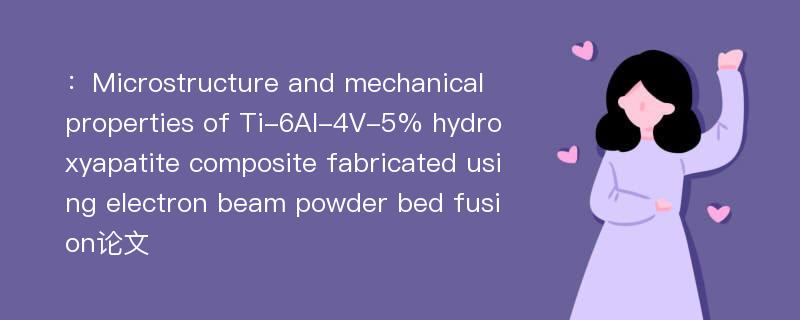
本文主要研究内容
作者(2019)在《Microstructure and mechanical properties of Ti-6Al-4V-5% hydroxyapatite composite fabricated using electron beam powder bed fusion》一文中研究指出:A novel, Ti-6 Al-4 V(Ti64)/Hydroxyapatite(HA at 5% by weight concentration) metal/ceramic composite has been fabricated using electron beam powder bed fusion(EPBF) additive manufacturing(AM): specifically, the commercial electron beam melting(EBM?) process. In addition to solid Ti64 and Ti64/5% HA samples, four different unit cell(model) open-cellular mesh structures for the Ti64/5% HA composite were fabricated having densities ranging from 0.68 to 1.12 g/cm~3, and corresponding Young’s moduli ranging from 2.9 to 8.0 GPa, and compressive strengths ranging from ~3 to 11 MPa. The solid Ti64/5%HA composite exhibited an optimal tensile strength of 123 MPa, and elongation of 5.5% in contrast to a maximum compressive strength of 875 MPa. Both the solid composite and mesh samples deformed primarily by brittle deformation, with the mesh samples exhibiting erratic, brittle crushing. Solid, EPBF-fabricated Ti64 samples had a Vickers microindentation hardness of 4.1 GPa while the Ti64/5%HA solid composite exhibited a Vickers microindentation hardness of 6.8 GPa. The lowest density Ti64/5%HA composite mesh strut sections had a Vickers microindentation hardness of 7.1 GPa. Optical metallography(OM) and scanning electron microscopy(SEM) analysis showed the HA dispersoids to be highly segregated along domain or grain boundaries, but homogeneously distributed along alpha(hcp) platelet boundaries within these domains in the Ti64 matrix for both the solid and mesh composites. The alpha platelet width varied from ~5 μm in the EPBF-fabricated Ti64 to ~1.1 m for the Ti64/5%HA mesh strut. The precursor HA powder diameter averaged 5 μm, in contrast to the dispersed HA particle diameters in the Ti64/5%HA composite which averaged 0.5 m. This work highlights the use of EPBF AM as a novel process for fabrication of a true composite structure, consisting of a Ti64 matrix and interspersed and exposed HA domains, which to the authors’ knowledge has not been reported before. The results also illustrate the prospects not only for fabricating specialized, novel composite bone replacement scaffolds and implants, through the combination of Ti64 and HA, but also prospects for producing a variety of related metal/ceramic composites using EPBF AM.
Abstract
A novel, Ti-6 Al-4 V(Ti64)/Hydroxyapatite(HA at 5% by weight concentration) metal/ceramic composite has been fabricated using electron beam powder bed fusion(EPBF) additive manufacturing(AM): specifically, the commercial electron beam melting(EBM?) process. In addition to solid Ti64 and Ti64/5% HA samples, four different unit cell(model) open-cellular mesh structures for the Ti64/5% HA composite were fabricated having densities ranging from 0.68 to 1.12 g/cm~3, and corresponding Young’s moduli ranging from 2.9 to 8.0 GPa, and compressive strengths ranging from ~3 to 11 MPa. The solid Ti64/5%HA composite exhibited an optimal tensile strength of 123 MPa, and elongation of 5.5% in contrast to a maximum compressive strength of 875 MPa. Both the solid composite and mesh samples deformed primarily by brittle deformation, with the mesh samples exhibiting erratic, brittle crushing. Solid, EPBF-fabricated Ti64 samples had a Vickers microindentation hardness of 4.1 GPa while the Ti64/5%HA solid composite exhibited a Vickers microindentation hardness of 6.8 GPa. The lowest density Ti64/5%HA composite mesh strut sections had a Vickers microindentation hardness of 7.1 GPa. Optical metallography(OM) and scanning electron microscopy(SEM) analysis showed the HA dispersoids to be highly segregated along domain or grain boundaries, but homogeneously distributed along alpha(hcp) platelet boundaries within these domains in the Ti64 matrix for both the solid and mesh composites. The alpha platelet width varied from ~5 μm in the EPBF-fabricated Ti64 to ~1.1 m for the Ti64/5%HA mesh strut. The precursor HA powder diameter averaged 5 μm, in contrast to the dispersed HA particle diameters in the Ti64/5%HA composite which averaged 0.5 m. This work highlights the use of EPBF AM as a novel process for fabrication of a true composite structure, consisting of a Ti64 matrix and interspersed and exposed HA domains, which to the authors’ knowledge has not been reported before. The results also illustrate the prospects not only for fabricating specialized, novel composite bone replacement scaffolds and implants, through the combination of Ti64 and HA, but also prospects for producing a variety of related metal/ceramic composites using EPBF AM.
论文参考文献
论文详细介绍
论文作者分别是来自Journal of Materials Science & Technology的,发表于刊物Journal of Materials Science & Technology2019年02期论文,是一篇关于,Journal of Materials Science & Technology2019年02期论文的文章。本文可供学术参考使用,各位学者可以免费参考阅读下载,文章观点不代表本站观点,资料来自Journal of Materials Science & Technology2019年02期论文网站,若本站收录的文献无意侵犯了您的著作版权,请联系我们删除。
